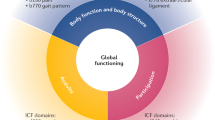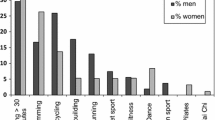Abstract
Physical therapy and exercise (recreational activity) are the cornerstones of non-pharmacologic therapy in axial spondyloarthritis (AxSpA) [1, 2]. These are components of physical activity, though physical activity is made up of activities beyond these and also include occupational activity. Not all activities in AxSpA appear to derive the same benefit for patients. In fact, it might be that while some activities are extremely beneficial for disease activity, function, and other outcomes, other activities may be harmful for the disease. The following review will examine animal model-based evidence and epidemiologic studies on physical activity in AxSpA.
Similar content being viewed by others
References
Ward MM, Deodhar A, Akl EA, et al. (2015) American College of Rheumatology/Spondylitis Association of America/Spondyloarthritis Research and Treatment Network 2015 Recommendations for the Treatment of Ankylosing Spondylitis and Nonradiographic Axial Spondyloarthritis. Arthritis & Rheumatology 1–17. doi: 10.1002/ART.39298
van den Berg R, Baraliakos X, Braun J, van der Heijde D (2012) First update of the current evidence for the management of ankylosing spondylitis with non-pharmacological treatment and non-biologic drugs: a systematic literature review for the ASAS/EULAR management recommendations in ankylosing spondylitis. Rheumatology 51:1388–1396. doi:10.1093/rheumatology/kes066
Starkie R, Ostrowski SR, Jauffred S, et al. Exercise and IL-6 infusion inhibit endotoxin-induced TNF-alpha production in humans. FASEB J 884–886
McGonagle D, Wakefield RJ, Tan AL et al (2008) Distinct topography of erosion and new bone formation in Achilles tendon enthesitis. Arthritis Rheum 58:2694–2699. doi:10.1002/art.23755
van der Heijde D, Landewe R, Einstein S et al (2008) Radiographic progression of ankylosing spondylitis after up to two years of treatment with etanercept. Arthritis Rheum 58:1324–1331. doi:10.1002/art.23471
Heijde DVD (2009) Assessment of radiographic progression in the spines of patients with ankylosing spondylitis treated with adalimumab for up to 2years. Arthritis Research & Therapy 1–8. doi: 10.1186/ar2794)
Heijde DVD, Landewé R, Baraliakos X et al (2008) Radiographic findings following two years of infliximab therapy in patients with ankylosing spondylitis. Arthritis Rheum 58:3063–3070. doi:10.1002/art.23901
Baraliakos X, Heldmann F, Callhoff J et al (2014) Which spinal lesions are associated with new bone formation in patients with ankylosing spondylitis treated with anti-TNF agents? A long-term observational study using MRI and conventional radiography. Ann Rheum Dis 73:1819–1825. doi:10.1136/annrheumdis-2013-203425
Chiowchanwisawakit P, Lambert RGW, Conner-Spady B, Maksymowych WP (2011) Focal fat lesions at vertebral corners on magnetic resonance imaging predict the development of new syndesmophytes in ankylosing spondylitis. Arthritis Rheum 63:2215–2225. doi:10.1002/art.30393
van der Heijde D, Machado P, Braun J et al (2012) MRI inflammation at the vertebral unit only marginally predicts new syndesmophyte formation: a multilevel analysis in patients with ankylosing spondylitis. Ann Rheum Dis 71:369–373. doi:10.1136/annrheumdis-2011-200208
Buchbender, C., Ostendorf, B., Ruhlmann, V., Heusch, P., Miese, F., Beiderwellen, K., et al. (2015) Hybrid 18F-labeled Fluoride Positron Emission Tomography/Magnetic Resonance (MR) Imaging of the Sacroiliac Joints and the Spine in Patients with Axial Spondyloarthritis: A Pilot Study Exploring the Link of MR Bone Pathologies and Increased Osteoblastic Activity. J Rheumatol 42(9):1631–1637. doi:10.3899/jrheum.150250
Pedersen SJ, Chiowchanwisawakit P, Lambert RG et al (2011) Resolution of inflammation following treatment of ankylosing spondylitis is associated with new bone formation. J Rheumatol 38:1349–1354
Maksymowych WP, Elewaut D, Schett G (2012) Motion for debate: the development of ankylosis in ankylosing spondylitis is largely dependent on inflammation. Arthritis Rheum 64:1713–1719. doi:10.1002/art.34442
McGonagle D, Thomas RC, Schett G (2013) Spondyloarthritis: may the force be with you? Annals of the Rheumatic Diseases 321–323
van Duivenvoorde L, Baeten D (2014) Comment on: “Spondyloarthritis:may the force be with you?,” the Editorial by McGonagle et al. 1–2. doi: 10.1136/annrheumdis-2014-205441&domain=pdf&date_stamp=2014-03-04
Baraliakos X, Braun J (2013) Evidence in support of the validity of the TNF brake hypothesis. Ann Rheum Dis 72:e32. doi:10.1136/annrheumdis-2013-204485
Baraliakos X, Braun J (2013) Response to “Evidence in Support of the Validity of the TNF Brake Hypothesis” by Maksymowych. Ann Rheum Dis 72:e32–e33. doi:10.1136/annrheumdis-2013-204493
Braem K, Carter S, Lories RJ (2012) Spontaneous arthritis and ankylosis in male DBA/1 mice: further evidence for a role of behavioral factors in “stress-induced arthritis.”. Bio Proced Online 14:1–1. doi:10.1186/1480-9222-14-10
Jacques P, McGonagle D (2014) The role of mechanical stress in the pathogenesis of spondyloarthritis and how to combat it. Best Pract Res Clin Rheumatol 28:703–710. doi:10.1016/j.berh.2014.10.009
van Duivenvoorde L, Dorris M, Satumitra N et al (2012) Relationship between inflammation, bone destruction, and osteoproliferation in spondyloarthritis in HLA-B27/Huβ2m transgenic rats. Arthritis Rheum 64:3210–3219. doi:10.1002/art.34600
Dagfinrud H, Kvien TK, Hagen KB (2008) Physiotherapy interventions for ankylosing spondylitis. Cochrane Database Syst Rev CD002822. doi: 10.1002/14651858.CD002822.pub3
Ward MM, Deodhar A, Akl EA, et al. (2015) American College of Rheumatology/Spondylitis Association of America/Spondyloarthritis Research and Treatment Network 2015 Recommendations for the Treatment of Ankylosing Spondylitis and Nonradiographic Axial Spondyloarthritis. Arthritis Care Res 1–16. doi: 10.1002/acr.22708
Patterson SL, Reveille JD, Lee M, Ward MM, Rahbar MH, Brown MA, et al. (2014) Better Outcomes in Ankylosing Spondylitis: The Synergistic Association Between Exercise and Tumor Necrosis Factor Inhibitors. Arthritis & Rheumatology. 66:250–251
Bernard B (Editor) (1997) Musculoskeletal disorders and workplace factors: a critical review of epidemiologic evidence for work- related musculoskeletal disorders of the neck, upper extremity, and low back. National Institute of Occupational Safety and Health (NIOSH) publication number 97-141. Cincinnati (OH): US Department of Health and Human Services
Anderson JH, Haahr JP, Frost P (2007) Risk factors for more severe regional musculoskeletal symptoms: a two-year prospective study of a general working population. Arthritis Rheum 1355–1364
DSouza JC, Franzblau A, Werner RA (2005) Review of epidemiologic studies on occupational factors and lower extremity musculoskeletal and vascular disorders and symptoms. J Occup Rehabil 129–165
Ward MM, Weisman MH, Davis JCJ, Reveille JD (2005) Risk Factors for Functional Limitations in Patients with Long-Standing Ankylosing Spondylitis. Arth Rheum 710–717. doi: 10.1002/art.21444
Ward MM, Reveille JD, Learch TJ et al (2008) Occupational physical activities and long-term functional and radiographic outcomes in patients with ankylosing spondylitis. Arthritis Rheum 59:822–832. doi:10.1002/art.23704
Ramiro S, Landewé R, van Tubergen A, et al. (2015) Lifestyle factors may modify the effect of disease activity on radiographic progression in patients with ankylosing spondylitis: a longitudinal analysis. RMD Open 1–8. doi: 10.1136/rmdopen-2015-000153
Author information
Authors and Affiliations
Corresponding author
Rights and permissions
About this article
Cite this article
Gensler, L. Physical activity in axial spondyloarthritis—tails from bench to bedside. Clin Rheumatol 35, 1443–1445 (2016). https://doi.org/10.1007/s10067-016-3264-3
Received:
Revised:
Accepted:
Published:
Issue Date:
DOI: https://doi.org/10.1007/s10067-016-3264-3




